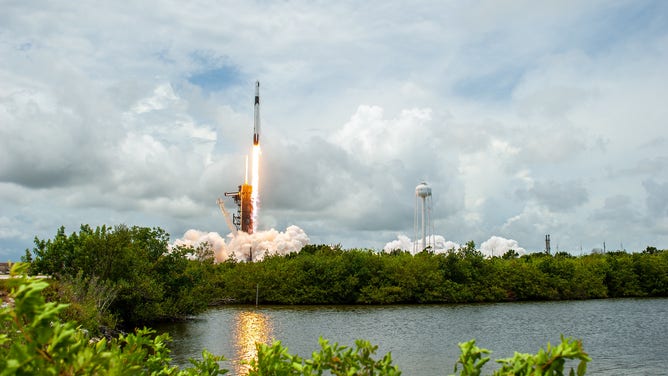Forecasting for a rocket launch begins months before liftoff
The 45th Weather Squadron's launch forecasting goes beyond Kennedy Space Center and Cape Canaveral

The SpaceX Falcon 9 rocket carrying the Dragon cargo capsule soars upward after lifting off from Launch Complex 39A at NASA's Kennedy Space Center in Florida on June 3, 2021, on the company's 22nd Commercial Resupply Services mission for the agency to the International Space Station. Liftoff was at 1:29 p.m. EDT.
(NASA)
"Go" or "no go" are the words mission managers wait to hear before a rocket blasts off from Florida's coast, and making sure the weather aligns for a safe liftoff is a critical job trusted to the launch weather officers of the 45th Weather Squadron.
Between hurricanes and sea breeze afternoon storms, the weather around launchpads at NASA's Kennedy Space Center and Cape Canaveral Space Force Station can be uncooperative. The group under the recently renamed Space Force's Space Launch Delta 45 is responsible for the Eastern Range, which includes the launch facilities and the Atlantic Ocean adjacent to the launchpads.
"So something on the order of about 15 million square miles. We're looking at a big chunk of the Atlantic Ocean that we're also looking at the weather and are responsible for the safe and efficient flight of a launch vehicle through that now," explains 45th Weather Squadron Weather Officer Mark Burger.
Weather is the primary reason for a launch scrub. However, Burger said, roughly two out of three attempts launch on time.
About five days out from a targeted launch window, the 45th will issue launch forecasts showing potential elements that might cause a scrub, including lightning, winds, rain and cloud cover. These "probability of violation" or POV forecasts include the likelihood of a weather issue violating a rocket's criteria for launch.

45th Weather Squadron Launch Officer Mark Burger.
(FOX Weather)
Each rocket has a unique launch profile, be it a SpaceX Falcon 9 or a United Launch Alliance Atlas V. Soon, a whole fleet of rockets from other private companies, including Blue Origin, Relativity Space and Firefly Aerospace, will begin launching from the Cape Canaveral launch complex.
"Every customer that comes to the launch services for support when it comes to weather, they all have different needs, but they all basically follow in terms of the range of safety criteria, so that includes weather," Burger said. "However, depending on the vehicle, they're user constrained. When it comes to weather, it can be slightly different as well."
Shortly after SpaceX began landing Falcon 9 rocket boosters at sea the 45th started including landing conditions for the Atlantic Ocean for those launches.
It's typical to see clouds referenced in these forecasts, most commonly cumulus clouds.
"Those are the kinds of clouds that look like cotton balls, and they get really big and puffy. And even if they don't support lightning, if they pass too close to the flight path or if they're high enough, they can actually force us to scrub," Burger said. "And those are the most common type of the cloud, very common in Florida, most of the year."
Safety from the ground to space
The 45th's work begins well ahead of launch because weather officers also forecast ground operations associated with getting a mission off Earth.
"It could be transporting a spacecraft between the Cape and KSC. It could be the transport of the vehicle out from a sheltered area to the pad itself," Burger said. "And many times these preparations and forecasts begin many weeks or even months ahead of schedule through what are called mission dress rehearsals or integrated crew exercises."
For the upcoming Crew-3 astronaut launch from Kennedy Space Center, NASA and SpaceX will go through a wet dress rehearsal of the countdown with the four astronauts. They'll take all the steps for liftoff but won't launch. The weather needs to be within specific safety parameters for this to happen, like on launch day.
In the days leading up to the countdown, people working at the launch site also need to have a heads-up of the potential for lighting. Ground teams need to clear out for active lighting. However, lighting criteria are even more serious on launch day. Lightning would mean "no go" for liftoff.
"Even clouds that bear an electrical charge would be an issue if that's a sufficient strength, whereas working on the ground, it's not likely to be," Burger said of the rockets over 200 feet tall.
Forecasters are looking out for natural lighting and rocket-triggered lighting if the vehicle flies through an atmospheric electric field.
Forecasting challenges in Florida
While the forecasting methods remain the same year-round, the potential weather violations in the summer versus the wintertime are different.
"Thunderstorms and the clouds associated with the thunderstorm are one of our biggest challenges," Burger said of Florida's stormy summers. "Certainly, during the wintertime, the incidence of thunderstorms associated with sea breeze or other features is much less."
Although less stormy, the cooler months present alternative challenges for launch weather forecasters.
"The winds upstairs, so that would be at the jet stream level, if they're sufficiently strong, they can induce forces on an ascending launch vehicle that are not desirable and even at the surface, right on the pad, if the winds are too strong they violate some of our wind constraints as well."
The 45th has brought on more launch weather officers in the last few years to accommodate the growing number of space companies launching from Florida.
Burger said the 45th Weather Squadron is "very much prepared to take that challenge on to ensure the safe and efficient flight of any customer who arrives."